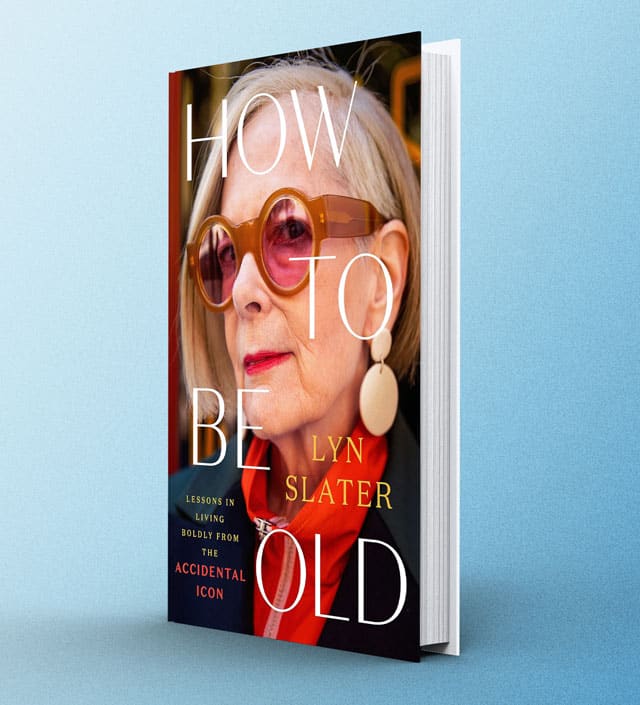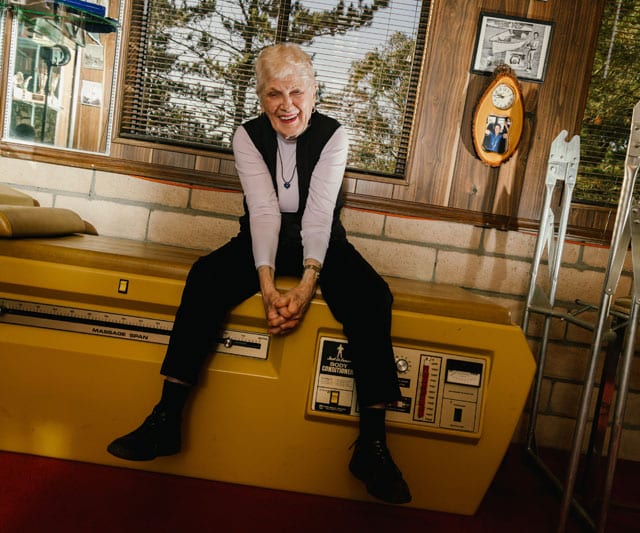Were she conventional, Lyn Slater, 71, could have entitled her book about surviving sudden celebrity in her 60s, “How Not to be Old,’’ and given readers all the usual advice about skirting decrepitude via diet, exercise, financial independence and emotional stability.
But Slater, who also goes by the social media moniker Accidental Icon, is determinedly unconventional, despite being raised in a strict Catholic home and thriving on old school relationships, with her partner of 25 years, her daughter, grandchildren and siblings.
Slater lets us know she’s against the grain with her photo on the cover of “How to be Old: Lessons in Living Boldly from the Accidental Icon.” It’s taken in tight close-up, so we can see her jowls, eye bags and sagging eyelids. Her hair is gray and white. She looks her age and perhaps a bit older.
But her chin-length hair is cut in several diagonal layers, her chic eyeglasses are oversized and her oyster-colored earrings are big dangling double hoops. There’s a saucy glint in her eye. Clearly, not your typical grandmother’s style.
She and her Asian-American partner, Calvin, with hair down to his waist, turned heads and attracted youthful admirers in New York, where they shared an apartment until COVID changed their lives.
From Professor to Fashion Icon
Slater’s Comme des Garcons and Japanese-influenced fashion look — eye-catching, even outlandish but never gauche — got her the Accidental Icon gig. She became a celebrated social media blogger, high-end products promoter (Hermes, Dior, Chanel), all-expenses paid traveler to Paris, London and other hotspots, and lecturer and teacher at design schools here and abroad.
A former professor and social worker, Slater dubbed herself Accidental Icon because she didn’t see herself as a deliberate anti-aging role model; she was too loose and spontaneous for master planning. But being a philosophical sort who reads extensively, she was disturbed to learn that young women are terrified of growing old, and old women feel put out to pasture. She blogged about that, to what became about 1 million followers.
She also didn’t identify with media portrayals of the old, as she puts it, “frail, demented, lonely, invisible and depressed; obese, no longer having sex, scorned by young people.’’
Or the extreme opposite depiction: the well-to-do who thrive through healthy eating, rigorous exercise, expensive beauty routines, and rewarding entrepreneurial careers that enable them to work for the rest of their lives.
“Trying not to be old becomes your full-time job. My fans who are in their sixties, soon to be seventies, like me, are looking for more meaningful ways to spend their time and money,’’ she writes, in 2023.
However, Slater admits that she loved the money and free travel that came with Accidental Icon celebrity. Her small apartment was jammed with free clothes and accessories for promotions.
Finding New Energy Among Youth
But more so, she enjoyed working with students on design projects and collaborating with young artisans and stylists on photo shoots for Accidental Icon blog and magazine features.
After capturing the hectic quality of city and celebrity life, “How to Be Old’’ achieves an autumnal tone when Slater realizes she needs to be near youth to be an old person who is not old. During COVID, she and Calvin buy a “new/old’’ fixer-upper house near Peekskill, N.Y., where her pregnant daughter, granddaughter, son-in-law and dying mother live.
Slater becomes a full-time babysitter, devoted gardener, home repairer and restorer, and she draws even closer to Calvin, who builds her a stunning pergola for their outdoor dining area.
Is it all too bucolic and fabulous? We can envy Slater’s great fortune, but we can still wish her well. If there’s a recipe for being happily old, doing your own thing looks like the way to go.
“What l have learned is that all you can control is the way you think about how to be old and respond creatively to the changes in your body as they happen. You can stay in the moment or worry about what hasn’t happened to you yet. You can accept stereotypes or be the exception. I’m reclaiming the word old because, as you know, I always believe we have the right to claim our own self-definition,” she says.
“How to Be Old: Lessons in Living Boldly from the Accidental Icon.’’ Penguin Random House. 264 pages. $28.
In a four-decade career in journalism, Eleanor O’Sullivan has reviewed many books on best practices for financial advisors, has written for Financial Advisor and the USA Today network, and was movie critic for the Asbury Park Press.







